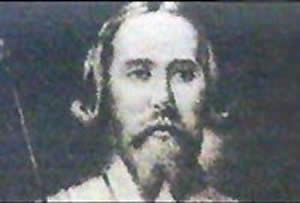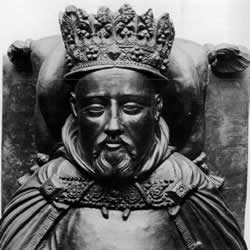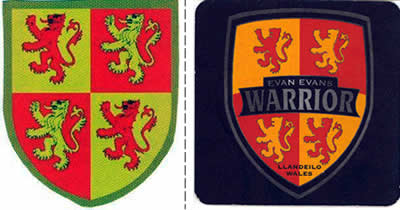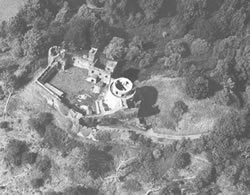When they burnt Llandeilo to the ground
Introduction
Llandeilo today is a peaceful rural town situated at the heart of the lovely Tywi valley. It's therefore difficult for us to believe how anyone would want to burn the place to the ground but in 1213, 1316 and again in 1403, that's exactly what this lovely, painted little town suffered (and at the hands of Welshmen each time, no less). As no-one has tried to reduce Llandeilo to ashes for six hundred years, hopefully the story of these three blazes can now be told without any untoward consequences.
Llandeilo in the Middle Ages
Llandeilo's strategic position as the capital of the medieval Welsh kingdom of Deheubarth means the area witnessed its share of violence during the middle ages. This was a time when wealth and power were acquired by the simple but effective means of taking it by force — and what was won by the sword could just as easily be lost by someone else's sword. The Llandeilo area featured many times during the turbulent periods of strife between the various medieval Welsh kingdoms; then again during the conquest of Wales by Edward I; and later still during the Welsh wars of independence. The poets and chronicles recall the battle of Ystrad Rwnws at the junction of the Tywi and Cothi rivers where in 1116 Owain ap Cadwgan, from the neighbouring Kingdom of Powys, was killed in revenge for the abduction of Princess Nest. In 1213 local magnate Rhys Gryg, having been defeated in battle near Talley, set fire to Llandeilo to prevent it falling into the hands of an invading army. An English force from Carmarthen was routed in 1257 at a running battle between Coed Lathen and Cymerau, known today as Broad Oak. The forces of Edward I captured Llandeilo and its surrounding district in 1277, before subduing the whole of Wales by 1282, though not before the ‘Battle of Llandeilo' on June 17th 1282 gave the Welsh a short-lived victory over the English. The town and castle were badly damaged by fire again during a Welsh revolt by Llywelyn Bren in 1316. Newton and Llandeilo were put to the torch in July 1403 during Owain Glyndwr's march through the Tywi Valley. Then nearby Carreg Cennen Castle was besieged by Yorkist forces in 1461 during the Wars of the Roses and partially demolished afterwards to ensure it couldn't be used again. No wonder Llandeilo church acquired a military watchtower in the 15th century to keep a close lookout for approaching armies. When the original medieval church building was demolished and rebuilt 1848–1850 , the watchtower was mercifully spared the Victorians' vandalism and still graces Llandeilo church to this day, hopefully no longer needed for its original purpose.
Rhys Gryg (Rhys the Hoarse), 1213
The first time Llandeilo folk felt tongues of flames licking all around them was in 1213, and the arsonist was one of their own. Rhys Gryg (Rhys the Hoarse — what a wonderful image that conjures) was the fourth son of the most famous and powerful man to have come from the Llandeilo area, Rhys ap Gruffydd (the Lord Rhys). Rhys ap Gruffydd (1130-1197) was the king of the medieval Welsh kingdom of Deheurbath (roughly the three modern west Wales counties of Carmarthen, Pembroke and Cardigan) with its capital here at Dinefwr castle, Llandeilo. When he wasn't warring against English kings, he was in constant battle against other Welsh princes, and any spare time was taken up fighting off the violent advances of his own family. In Rhys ap Gruffydd's old age he had a great deal of trouble keeping control of his sons, and a bitter feud broke out between two of them, Gruffydd ap Rhys II and his brother Maelgwn ap Rhys. Rhys Gryg, his fourth son, formed an alliance with Gruffydd against Maelgwn, then in 1195 joined with another brother, Maredudd, in a conspiracy against their father and captured Dinefwr Castle. Their father, however, retaliated by capturing both of them and imprisoning them in Ystrad Meurig Castle in Cardiganshire.
Two of Rhys Gryg's nephews kept up the tradition of family violence in 1213 when, supported by an English army, they attacked and defeated him at Talley near Llandeilo and stripped him of his lands, which were then given to the two nephews. The term dysfunctional family may well be a modern phrase but it certainly isn't a modern concept and in the Middle Ages dysfunctionality was more like the norm, certainly amongst the so-called nobility.
It was after this defeat by his nephews in 1213 that Rhys Gryg set fire to Llandeilo to prevent the town falling into the hands of the invading English army. Rhys Gryg had also attacked and burned Swansea to the ground in 1212, which clearly gave him practice for Llandeilo's conflagration.
Llywelyn Bren, 1316
1316 saw the short-lived rebellion of Llywelyn Bren in Glamorgan, attempting a return to a Welsh monarchy. Like a later Welsh rebel, Owain Glyndwr, Llywelyn Bren lost lands to the English and rose up against their high-handed treatment of Welsh gentry like himself. In a climate of general discontent throughout Wales, Llywelyn had no difficulty in raising a widespread revolt among the hillsmen of Glamorgan, which quickly spread into Carmarhenshire, Llandeilo included. The rebellion, though attended by serious devastation of the Vale and a number of determined attacks on several important strongholds, was over in a few weeks, but not before Llandeilo had felt the heat of flames once more. The damage was so great that three years later Llandeilo townsfolk were given exemption from a nationwide tax raised to fund the King's Scottish wars.
Llywelyn was finally captured by Hugh Despenser, the favourite of Edward II, in 1317. His estates in the Senghenydd area were seized and he was brought to Cardiff where he suffered a traitor's death by being hanged, drawn and quartered. Despenser was also given Dinefwr castle and its lands by the king, which was enough to provoke an attack on Dinefwr castle and township in 1321 by the English lords who'd been dispossessed. When Edward II was deposed in 1327, replaced by his son Edward III, and murdered in September at Berkeley castle, justice finally caught up with the hated Despenser. He was also executed in 1327, like Llywelyn Bren being hanged, drawn and quartered, but with castration added for good measure. The murder of Llywelyn Bren had been one of the charges made against Despenser, so some sort of posthumous justice was done, and Llywelyn's children were given his lands back.
Owain Glyndwr

Llandeilo remained flame-free for almost a century until yet another Welsh nobleman and sociopath reached for the matches in July 1403. It happened during the most turbulent period in Welsh history, popularly known as the Glyndwr revolt, a period of pitched battle and guerrilla war from 1400 to about 1415 AD. As a result of that war of independence against the English King Henry IV in these years, Owain Glyndwr has become the most potent figurehead for Welsh Nationalism, accorded near-divine status by the more ardent followers of that political creed.

Yet Owain Glyndwr (circa 1349 – 1416) was originally a collaborator of the English monarchy, his family receiving wealthy lands in north-east Wales only through a calculated association with the powerful Marcher lords who ruled the lands on the Welsh-English border. He was thus rooted in the official class in the March and figured among its lesser nobility. By training, he belonged to that most establishment of all professions – the law – having served as a lawyer in the Inns of Court in London for a time. Glyndwr had also served in the wars and retinues of Henry of Lancaster (the future Henry IV); the earl of Arundel; and fought with distinction with the English against the Scots in 1385. During the Battle of Radcot Bridge in December 1387, a revolt against King Richard II, Glyndwr had served as squire to Henry of Lancaster against Richard . But from 1400 former squire and master would be mortal enemies until the death of Henry IV in 1413.

The change of heart co-incided with a change of king when Glyndwr's erstwhile ally, Henry of Lancaster, defeated and killed Richard II in 1399 to become Henry IV. In 1399 – 1400 Glyndwr ran up against his powerful neighbour, Reginald de Grey, Lord of Ruthin, an intimate of the new king. The quarrel was over common land which, Glyndwr claimed, Grey had stolen. The matter was sent to the King for arbitration who sided with his friend Grey. Glyndwr's response was startling and may have even startled Glyndwr himself. Supported by other Norman-Welsh Marchers and the Dean of St Asaph, he attacked Ruthin with several hundred men and went on to savage every town in north-east Wales. There was an immediate response from Oxford, where Welsh scholars at once dropped their books and flocked home. Even more dramatic was the news that Welsh labourers in England were downing their tools and heading for home. The English parliament immediately rushed ferociously anti-Welsh legislation onto the statute books. Henry IV marched a large army right across north Wales, burning and looting without mercy. Whole populations scrambled to make their peace as the war raged in undiminished fury for ten years and didn't really end for fifteen.
Glyndwr, it has to be said, caught a popular mood of discontent which had been simmering for over a century amongst the Welsh, commoners and gentry alike, a century that had seen expropriation, ethnic cleansing, colonisation, discrimination and humiliation following hard on the conquest of Wales by Edward I in 1282.

The treatment of the defeated Welsh was discriminatory by anyone's definitions, and not just by Edward I in the years immediately after the conquest of 1282 either. To give just one example, Richard II extended the privileges of the English on 13th May 1392 when he granted legal immunity to the burgesses (ie, townships) that they should not be fined by any Welshman in any of the royal courts of Cardiganshire and Carmarthenshire.
By 1403, the year he came to Llandeilo, Glyndwr controlled most of Wales. A minor legal dispute over a tiny parcel of land had escalated into a full-blown war of independence, not something many of us resort to in our dealings with our neighbours, no matter how much we may feel like it at times. At the ripe old age of 51, when most of us are winding down our lives and reaching for the proverbial slippers, Glyndwr changed from lawyer and country gentleman into maniacal warlord. So confident was he in the success of his venture that in 1404 he convened a parliament at Machynllech at which he was crowned Prince of Wales, a status that was even recognised by England's enemies France and Spain. It was not to last, but while it did, Glyndwr and his guerilla army wreaked havoc on English-held towns that had the misfortune to be in his way, one of which in July 1403 was Llandeilo.
In the early Middle Ages Llandeilo was the site of two townships, one of which has long disappeared. Today's Llandeilo was the earlier town, centred on a religious settlement founded in the 5th century and dedicated to St Teilo. The medieval monastery has long been demolished, but was probably close to where the parish church of St Teilo now stands. The township of Llandeilo Fawr and its surrounding lands was owned by the Bishop of St David's and administered of the local abbot, while the military occupants of Dinefwr castle ruled over Newton, a borough quite separate from Llandeilo Fawr, which reached the peak of its population and prosperity in the years around 1400.

After Dinefwr castle was built in the twelfth century, probably by the local Welsh Prince, Rhys ap Gruffydd (the Lord Rhys, 1130-1197), a township grew around the castle, originally a Welsh community when the castle was still in Welsh hands. But after the conquest of Wales by Edward I in 1282, all the land of Wales was taken away from the native Welsh and distributed among supporters of the king, and a new town for English incomers was built a mile away from Dinefwr castle and its Welsh town. This new settlement became known, not surprisingly, as the New Town or Newton, situated where the modern Newton House now stands.

Newton even had its own place of worship at Llandyfeisant, though the stone church buried deep in Castle Woods is fairly recent, the original medieval church having been demolished around 1858 to make way for the completely rebuilt Victorian church we see today. It seems there was also a church inside Dinefwr castle for its occupants to worship. Both the Welsh and English towns in Dinefwr have vanished completely, leaving only a few tantalising mentions in old documents to testify to their existence. A traveller to Newton called John Leland noted in the 1530s that nothing remained save ‘sometime a long street now ruinous'.
The relentless progress of Owain Glyndwr's forces towards Llandeilo is best left to Professor Ralph A. Griffiths, the leading historian of medieval Carmarthenshire:
The Glyndwr rebellion was a decisive phase in the history of both Dinefwr and Llandeilo. This was less because of the ten-day assault on the castle and borough of Dinefwr during July 1403, but rather a consequence of new circumstances created by the rebellion. Our knowledge of how the two towns fared is mainly based on a series of vivid letters, or reports of letters, sent by the constable of Dinefwr castle, Jenkin Havard, to his ‘dear friend', John Fairford, receiver of the lordship of Brecon, in July 1403 when Glyndwr's forces, partly raised in Carmarthenshire, were swarming over the countryside and battering at his gate.
Glyndwr himself appeared on 2nd July and laid siege to the castle, while the bulk of his army prepared to march to Carmarthen and Kidwelly. On 4th July, Fairford reported Havard's desperate plight to the authorities of Herefordshire, imploring prompt assistance for his friend. That very morning, he had received dreadful news of the menace to Havard and Dinefwr. Another messenger had arrived from Lord Audley's lieutenant at Llandovery castle with equally grave news: on 3rd July Glyndwr and 300 rebels had surprised Llandovery's garrison, which offered little resistance, and that night they lodged at Llandeilo. Fairford's reports were also passed to Sir Hugh Waterton, an intimate servant and councillor of King Henry IV, and steward of Brecon, Monmouth and the duchy of Lancaster lands in Herefordshire. The messenger elaborated in person: the towns of Llandovery and Newton had been burned by the rebels, who were believed to be beating a path of destruction as far as Kidwelly; only severe flooding was temporarily hindering their progress. The chamberlain of South Wales had been driven into Carmarthen, and some of his men had been killed.
On 7th July, the embattled Havard reported, ‘in haste and in dread', that the castle at Newcastle Emlyn had surrendered, the rebel leaders had forced Carmarthen castle to capitulate, and they had burst into the borough of Carmarthen, set fire to its buildings and slain over fifty of its inhabitants. Yet, Dinefwr castle still held out, albeit in increasingly desperate straits: ‘a siege is ordained at the castle that I keep and that is great peril for me, and all that be within; for they have made their vow that they will all yet have us dead therein'. His sense of isolation deepened when Glyndwr was welcomed into Dryslwyn castle by its constable, Rhys ap Gruffydd ap Llywelyn Foethus. Even John Scudamore, the Herefordshire squire who held Carreg Cennen castle for the king, felt it wise to visit the rebel leader to seek a safe-conduct for his wife and mother-in-law out of the danger zone—which was humiliatingly refused. If speedy aid were not forthcoming, Havard and his men would have to escape to Brecon under cover of darkness ‘because that we fail victuals and men, and especially men'.
Havard was still defying the besiegers four days later, when he again lamented his position. The relief that he may have felt when Glyndwr pressed on to southern Carmarthenshire to confront Lord Carew evaporated when the Glyndwr made an agreement with Carew and returned to Carmarthen. Once again a desperate note entered the constable's communications. He pleaded for relief, for the rebels ‘have goods and victuals plenty, for every house is full about us of its poultry, and yet wine and honey enough in the country, and wheat and beans, and all manner victuals'. At the same time, he was forced to parley daily with the rebels, who now numbered about 8,240 spears, ‘and now will ordain for us to leave that castle for there casts to be encircled thence'. Both besiegers and besieged were well aware of the historical significance of Dinefwr castle for control of Ystrad Tywi, ‘for that was the chief place in old time'. ‘God of Heaven save you and us from all enemies', he concluded on behalf of himself and John Fairford at Brecon.
Remarkably, Dinefwr castle does not seem to have fallen in the summer of 1403. The threat was suddenly lifted as a result, partly of the ambush of a rebel band by Lord Carew to the north of Carmarthen during the night of 11-12th July, and partly of the receipt of news of the Percy uprising announced at Chester on 10 July. But the damage caused was considerable. By 1409 £89 was being spent on repairs to the castle and on the construction of new buildings there. Details of the rebuilding needed at the towns of Llandeilo Fawr and Newton, largely destroyed in July 1403, are lacking.
The events of July 1403 in Llandeilo are also described by a biographer of Owain Glyndwr:
by 2nd July Owain had appeared in person to put new heart into the Welsh rebels of the Tywi valley. They hurried to join him, swearing oaths of fealty to prove their newfound enthusiasm. Llanymddyfri [Llandovery] was attacked with ferocity before the patriots moved westwards towards Dinefwr, an intimidating array of eight thousand lances causing unprecedented alarm among the formerly complacent castellans. On the 3rd July they camped at Llandeilo then marched on to Dryslwyn the following day, recruiting more men as they marched. The gates of Dryslwyn were thrown open by the warden, Rhys ap Gruffydd, and Glyn Dwr was welcomed into the castle.
The inhabitants of nearby Carreg Cennen were terrified; there were ladies trapped within the castle by this swift advance. The Keeper, John Scudamore, requested safe passage for the women, but his plea was ignored. Obviously Glyn Dwr's attitudes had hardened considerably over the past few years. The family man of the 1390s had become an unemotional crusader, driven by circumstances to forget his chivalrous upbringing…
The army marched on to Carmarthen, where other loyalists joined Glyn Dwr. Among these were Rhys Ddu, or Rhys the Black of Aberteifi; Rhys Gethin the Fierce, hero of Pilleth, from the Vale of Conwy; Henry Don of South Wales, a man to whom Glyn Dwr had written as a friend immediately after the first tremor; and William Gwyn of Kidwelly who was a landowner in the Caerfyddin district whose intentions had been regarded as loyal to the King, until now. Their followers swelled the numbers of the rebel army, which displayed an intimidating solidarity to those who were defending strategic, but isolated, positions in the locality.
Frantic letters were sent from distraught wardens to inform King Henry that his castles were besieged, attacked and very vulnerable.
The Keeper of Newcastle Emlyn, Jenkin ap Llywelyn, prudently chose to surrender without a fight. This opportune gift opened up the route to the North, and Welsh forces increased their attacks on Carmarthen town and castle, secure in the knowledge that the road was safely held in the rear should they need to withdraw quickly. On 6th July the Welsh were given the keys of Carmarthen by a defeated and terrified castellan, Wigmore, who saw no point in prolonging the fight against such a host.
Sources
- Tale of Two Towns: Llandeilo Fawr and Dinefwr in the Middle Ages, by Ralph A Griffiths. Published in Sir Gar: Studies in Carmarthenshire History by Carmarthenshire Antiquarian Society 1991, edited Heather James. A Tale of Two Towns is the best history of medieval Llandeilo, outlining the history of the two townships over several centuries.
- Insurrection in Wales: the rebellion of the Welsh led by Owen Glyn Dwr against the English Crown in 1400, by D. Helen Allday, Suffolk, 1981
- Oxford Dictionary of National Biography (DNB). First published in the 19th century, the latest, fully revised DNB appeared in 2004. Its 60 encyclopaedia-sized, double-columned volumes contain entries for over 55,000 of the country’s great and good (including plenty of the not-so-good) from Roman times to the present. Contains entries for Rhys Gryg, Llywelyn Bren and Owain Glyndwr